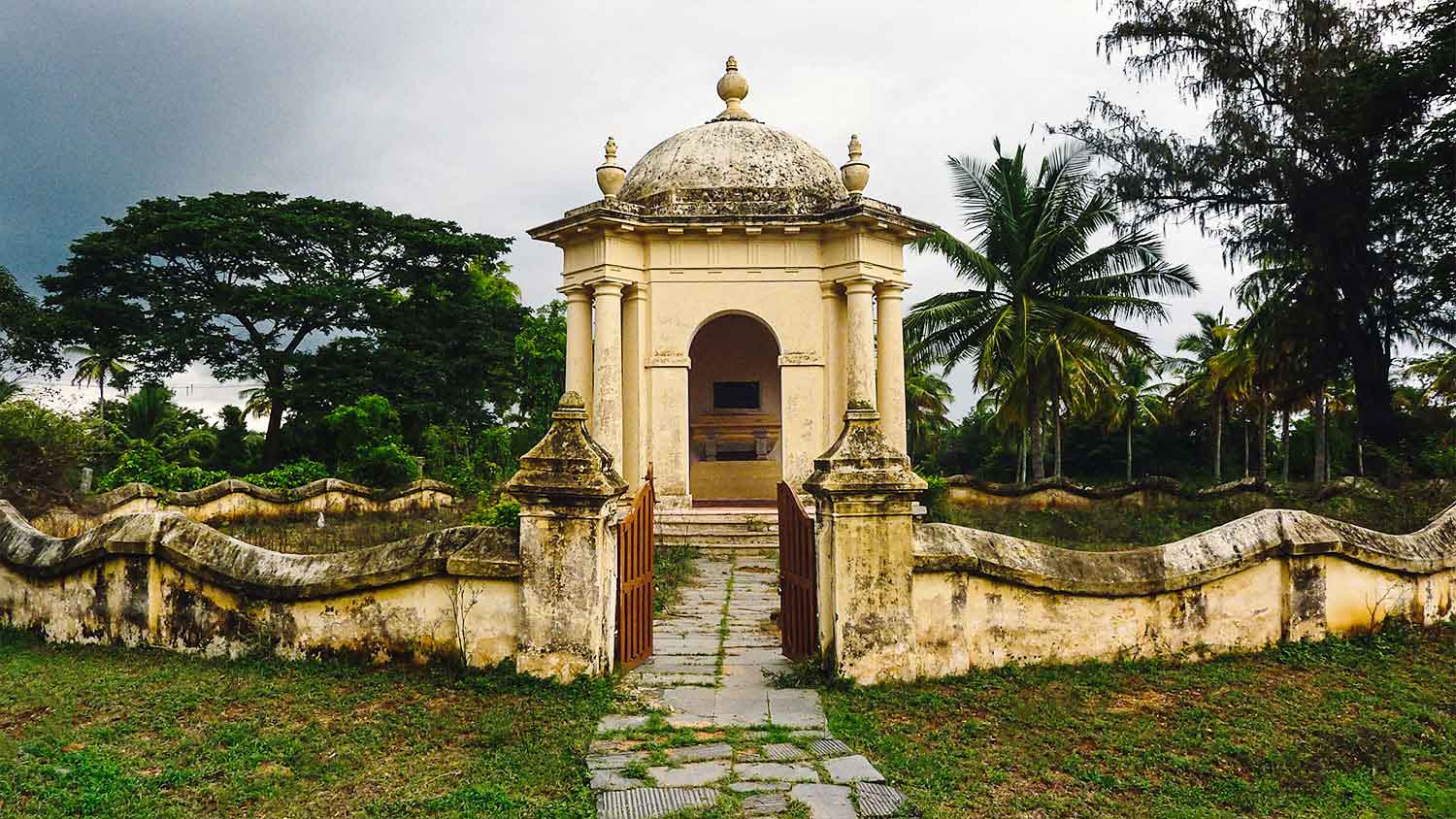Remembering William Baillie, Defeated By Tipu Sultan
Baillie is reported to have said to Haidar Ali: “Your son will inform you that you owe the victory to our disaster rather than to our defeat."

Some came for king and country, some for fame and fortune, first in a trickle and then in a flood, from Europe to India, and many among them came young to a place that was part welcoming, part hostile, riven all over, and tempting to take and possess. Fame and fortune favored a few, and king and country honored a good number, but what is the story of the larger remainder? The story of solid men like William Baillie, for instance?
I heard his story and saw his after-story in Srirangapattana, 125 kilometers southwest of Bangalore, a shout away from expanding Mysore. In that battle for Srirangapattana, young Arthur Wellesley found form and foundational confidence that helped him defeat Napoleon sixteen years later, at Waterloo. After Srirangapattana, the colonizer’s push for the entire subcontinent was over—with some mopping up left. On my part, I’d gone there to experience the story of Haidar Ali and Tipu Sultan, father and son, our heroes, implacable foes of the British for 38 years. But I’ve come back with thoughts for the Baillies of Britain.
Col. Baillie’s Dungeon in Srirangapattana is clean and white-coated on the inside and well swept. Fresh air blows about the place, the breeze coming across the waters to this river-island, beating and rising up the fort wall, and playing over the flat-topped dungeon there. This is not a dungeon in the deep; it is a squat building in a dugout on a rise. I’ve been there thrice over ten years, and it has always been kept up for tourists, to whom tour guides tell with pride about the rout of Col. Baillie in the Battle of Pollilur, near Kanchipuram, in Tamil Nadu. Haidar Ali and Tipu Sultan led that battle together, and, whereas it was for them their most cherished victory, for the British no defeat in India caused so much anguish as this one.
Col. Baillie commanded the British detachment in that battle, and, having surrendered, he was brought drained and bloodied into the dungeon at Srirangapattana, capital city of Haidar and Tipu.
The dungeon fronts the south, with arches running end to end. A yard runs the full length before it. It is a low-roof structure, held up by obese columns whose girth seems overdone, but, perhaps, the breadth served to secure a man on each face of them. If fifty prisoners were held in that hall they’d be stifled in the heat of Srirangapattana; if a hundred, they’d be choking. It seems small for an expanding kingdom forever in battle, which would’ve taken thousands of prisoners from its victories, but of course this one was in the capital, a mere five minutes by foot from Lal Mahal, the principal palace of Tipu, and so it was a special possession of his, where he kept very special prisoners.
A prison for prize catch. And Baillie was a shining trophy, even if ill and dying. He was held there together with David Baird, who had fought the battle with him and was captain at the time, along with other officers. Baird would be freed by treaty in 1784, and would return to Srirangapattana fifteen years afterward as second-in-command, and avenge his incarceration.
Baillie wasn’t so fortunate.
Everything had worked for the Mysore forces at Pollilur. Their numbers were superior, whereas Baillie was bringing back a mere detachment to merge with the main, which was in Sir Hector Munro’s charge in Kanchipuram. Haidar dispatched Tipu with 10,000 troops to intercept Baillie’s 2,800. Pollilur was close enough for Munro to know how the battle was going, but he chose to hold back and secure his provisions. Mysore had been joined by a French unit, fit and in form under the command of M. Lally. Never giving up conviction that reinforcements would come, Baillie gave dogged resistance that his surviving comrades praised afterward. But the odds turned against him altogether when a Mysore rocket found his ordnance pile. The explosion threw the sepoys into panic, and they couldn’t be rallied by the Europeans, and it fell upon them to rally round their compatriot, which they did, holding out against Tipu’s horses which came upon them in waves. Baillie soldiered on until all but sixteen of his men and officers had been killed or wounded.
“Your son will inform you that you owe the victory to our disaster rather than to our defeat,” Baillie is reported to have told Haidar.
That was in September, 1780. Baillie survived a mere two years in captivity; he died in the dungeon in November 1782. In the following month Haidar Ali died also, from a carbuncular growth on his back. Tipu ascended the throne and declared himself Sultan. He was thirty-two.
Seventeen years later, the British, having halved Tipu’s realm over the time, having negotiated with Tipu’s neighbors and arrayed every one of them against his landlocked kingdom, and having gotten their alliance to buy up some of Tipu’s top commanders, they laid siege to Srirangapattana. The siege lasted two months, but after they’d breached the fort they took the capital, and Tipu’s life with it, all in one hour. Within 48 hours after that, they’d given Tipu’s bier a gun salute and interred his body in the same Gumbaz the Sultan had built for his father Haidar. Both British and local historians acknowledge that a good number of Tipu’s subjects lined the passage of the carriage and bowed for their fallen ruler. Both acknowledge that the heavens wept and a mighty storm broke upon the blood-drenched island.
There’s nobody who doesn’t acknowledge the pillage in spite of the mighty monsoon that May in 1799. Writers for the British say Arthur Wellesley put an end to it in two days. Others aver the looting went on and on. At any rate, swords and precious stones and gold and even the amulet on Tipu went far west into private estates. Speaking of stones, and considering how the wars with the exotic Tipu had been painted by the East India Company at home, an imagination fired, and Wilkie Collins wrote Moonstone in 1868, a detective story (the first ever, it is said) on the mysterious disappearance of a diamond (not the semiprecious moonstone) obtained by plunder by an Englishman in Srirangapattana.
The Gumbaz is a ten minute drive from the eastern gate of the fort. It shines today as it must have shone in Tipu’s days. The garden around it cannot be as beautiful as in kingly times, but it is as good as it can get on a republican government’s budget. The green of the broad lawns glitters in blazing light, and there is shade from plentiful trees, but the long walk from the main gate to the Gumbaz is unshaded. The sight is pleasing, though, and so the heat is bearable. Inside, the walls and the dome and the rug that is draped over Tipu’s sarcophagus are all covered in tiger burris (stripes). That is not surprising. In his time tiger burris decorated every garment and seat and musket and pistol and cannon and wall and ceiling and cushion and sword and dagger and knife and flag and the howdah on the elephant of the Sultan. Every object upon which his eyes fell had to remind him of the tiger.
The story of Tipu touches everyone, for the fact that he fell fighting, and was found under a heap of corpses with his sword clutched tight in his hand. As I watched inside the Gumbaz, an occasional Hindu folded hands; many Muslim men and women kneeled and prayed as one would to a saint. Few failed to bend over and run a hand over the tiger-stripe rug on Tipu’s sarcophagus. My wife ran her fingers on it, and struggled with the perfume that lingered on her fingers all the way home to Bangalore. Attar is a new scent for her. Not so many paid that honor to Haidar, a man just as brave, and brilliant, and who fought the British with (perhaps) greater determination, and gave his son the conceit of a ruler and general.
The Gumbaz draws many tourists and almost none notice a modest structure right by the gate to the vast compound of the Gumbaz.
Seventeen years after Tipu’s fall, thirty-five years after William Baillie had been dead, a nephew of his, Lt. Col. John Baillie, who was resident at the Lucknow Court of the Nawab of Oudh, built a mausoleum for him a few yards off the entrance to the sprawl of the Gumbaz. He put a small, low enclosure round it. It is an austere structure, but pretty, and poignant, evoking in its desolation the misfortune of a man who’d been as brave and as resolute as Tipu. Col. Baillie died much too soon to know that two days before his countrymen stormed Srirangapattana, British fire fell on Tipu’s rocket pile, and caused an explosion inside the fort, a greater explosion than the one which had turned the Pollilur battle against the colonel. The fire and the smoke and the sound shook Mysore’s defenders, though they’d been on the ready for the din of battle, knowing the assault was coming any moment.
“Poor man,” I told my wife, taking time to take pictures of Baillie’s decrepit mausoleum, taking care not to step on dung and horse droppings and the turd of humans. The small gates to the wasting mausoleum were open, but no one was going in. The monument is not on the tour guide’s checklist. Grime caused by weather has dried on it, and though it has been painted sometimes, the paint has flaked.
“I don’t know,” my wife said. “Why did he come here in the first place?”
One feels for the fallen, in spite of the honest, and correct, question. I have always considered the colonizer as admirably intrepid and I have abhorred their avarice, but, looking for information on the times on the net, I came upon a letter from a young Englishman, twenty-year-old Archibald Hope, written home to his father from the dungeon in Srirangapattana. The prisoners knew ways to smuggle letters out.
> About the middle of December when we had recovered from our wounds we were sent up here (from Arni) which is the capital of Haidar’s country where I was so fortunate as to meet with my friends Captain Baird and Lieutenant Lindsay — here we were put upon a scanty allowance hardly sufficient to support nature dragging on a miserable existence loaded with irons and every hardship that a close imprisonment and infamous usage for 22 months could inflict upon a set of the most unfortunate men that ever existed. About a month ago I was attacked with flux billuus (sic) fever and the liver. Youth and a good constitution struggled along with these three complaints but they are now almost overpowered and I am attacked with the fatal symptom (a hickup) as I find my end approaching I request that you will never send a son of yours to this country unless you wish to make him miserable. I have empowered Captain Baird to settle all my affairs in this country. I will refer you to him for an account of them and everything else relating to me since my arrival in this country. My due love and affection to Lady Hope, sisters, brothers, the family of Castle Semple, my Uncle, Captain MacDowall, and all other friends.
> I remain,
> My dear Sir
> Yours most affectionately
> A. Hope
The letter is dated July 5, 1782.
A slightly modified version of this post was published in the print edition of The Deccan Herald.
